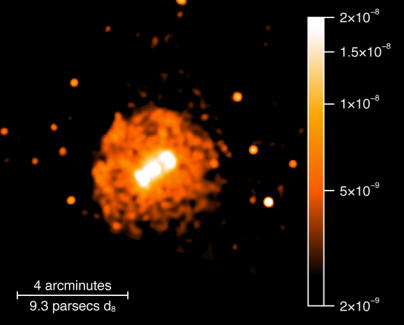Astronomers have identified the glowing wreck of a star that exploded a mere 2,500 years ago — the blink of an eye in astronomical terms - and revealed an astrophysical novelty of the Milky Way.
Situated in the plane of the Milky Way 24,000 to 30,000 light years from Earth in the constellation Circinus, the neutron dubbed Circinus X-1 is what astronomers call an X-ray binary, a system where an evolving star and a black hole or neutron star closely orbit one another and produce X-rays as material from the evolving star spirals in to its denser companion and is heated to very high temperatures.
The new observations, made by a team led by University of Wisconsin-Madison astronomy professor Sebastian Heinz, reveal a glowing nebula created when the star exploded and, inside of it, the collapsed core of the exploded star, a neutron star, still clinging to its former companion star. It is the only known example of such a system in our galaxy.

Chandra X-ray image of the supernova remnant and jet of Circinus X-1 in the energy range 1-3 keV. Adaptive binning to a signal-to-noise of 4 per resolution element and Gaussian smoothing with 10 pixel FWHM were applied for noise reduction. The CCD read-out streak was removed from the image according to standard practices. The central elongated brightness enhancement (yellow-white color) is due to the neutron star point source and the bi-polar jet emission (Heinz et al. 2007; Soleri et al. 2009; Sell et al. 2010). The scale bar shows an angular scale of 4 arcminutes. The color bar shows the surface brightness scale in units of photons s -1 cm -2 arcsec -2 . The image is oriented such that North is up and East is to the Left. Credit:
arXiv:1312.0632
Most X-ray binaries are quite old and no longer have a supernova remnant. To find the shell of ionized gas that marks the supernova blast that created the X-ray binary system is a rarity, according to Heinz. "It basically creates the historical record of that explosion. They don't last very long, so they are quite accurate clocks for finding things that are recent," says Heinz.
"This particular remnant is only about 2,500 years old, which makes the system the youngest known X-ray binary," Heinz explains, referring to the two-star system that is among the most luminous sources of X-rays in the galaxy. "In terms of a human lifetime, it would be roughly akin to a newborn just a few days old," adds Paul Sell, a former UW-Madison graduate student involved in the study.
When a once-massive star explodes as a supernova, it creates either a black hole or a neutron star, a condensed, rapidly-spinning cinder with extraordinary gravitational pull. Most neutron stars, which pack the mass of about 1.4 suns into a ball just 20 or so kilometers in diameter, exist in isolation. "In the Milky Way, there are only about a hundred other neutron stars we are aware of that have held onto their companion stars," Heinz notes.
It is much rarer still to observe the hallmark of a supernova explosion, the glowing cloud of ionized gas created by the shock wave of the blast as it crashes into the interstellar gas around the stars. "The shock wave from a supernova can only be seen for about 100,000 years or so before it dissipates and merges with the rest of the gas and dust around it in space," says Sell. "This is only a small fraction of the lifetime of an X-ray binary, making the chance to find one in this early phase of its life very small."
"The fact that we have this remnant along with the neutron star and its companion means we can test all kinds of things," says Heinz. "Our observations solve a number of puzzles both about this object and the way that neutron stars evolve after they are born. For example, the unusual elliptical orbit on which these two stars swing around each other is exactly what you would expect for a very young X-ray binary," notes Heinz.
However, the observations also pose new questions: Previous X-ray observations revealed that the Circinus X-1's neutron star has a relatively small magnetic field. "General theory holds neutron stars are born with a large magnetic field," says Heinz. "This newly minted neutron star has a field much smaller than expected."
Why that's the case remains a mystery. "Circinus X-1 appears to be a unique X-ray binary, probably in large part because it is so young," adds Sell, now a post-doctoral fellow at Texas Tech University.





Comments